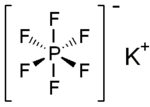Potassium hexafluorophosphate
| Structural formula | ||||||||||||||||
|---|---|---|---|---|---|---|---|---|---|---|---|---|---|---|---|---|

|
||||||||||||||||
| General | ||||||||||||||||
| Surname | Potassium hexafluorophosphate | |||||||||||||||
| other names |
Potassium phosphorus hexafluoride |
|||||||||||||||
| Molecular formula | K [PF 6 ] | |||||||||||||||
| Brief description |
white solid |
|||||||||||||||
| External identifiers / databases | ||||||||||||||||
|
||||||||||||||||
| properties | ||||||||||||||||
| Molar mass | 184.06 g mol −1 | |||||||||||||||
| Physical state |
firmly |
|||||||||||||||
| density |
2.75 g cm −3 (25 ° C) |
|||||||||||||||
| Melting point |
575 ° C |
|||||||||||||||
| safety instructions | ||||||||||||||||
|
||||||||||||||||
| Toxicological data | ||||||||||||||||
| As far as possible and customary, SI units are used. Unless otherwise noted, the data given apply to standard conditions . | ||||||||||||||||
Potassium hexafluorophosphate is an inorganic chemical compound of potassium from the group of hexafluorophosphates .
Extraction and presentation
Potassium hexafluorophosphate can be obtained by reacting tetrachlorophosphonium hexafluorophosphate with potassium hydroxide .
It can also be made by reacting phosphorus pentafluoride with potassium fluoride .
It is also possible to obtain it by reacting phosphorus pentachloride with potassium chloride and hydrogen fluoride . This reaction can also be used to prepare analogous compounds such as sodium hexafluorophosphate or ammonium hexafluorophosphate .
properties
Potassium hexafluorophosphate is a colorless solid that comes in the form of square and rectangular thick sheets. It melts when it is red hot with partial decomposition. When heated with solid sodium hydroxide , vigorous conversion to fluoride and phosphate takes place above 400 ° C. It has a crystal structure with a face-centered cubic lattice and the space group Pa3. The transition to a different crystal structure occurs below −25 ° C.
See also
- Ammonium hexafluorophosphate
- Lithium hexafluorophosphate
- Sodium hexafluorophosphate
- Silver hexafluorophosphate
Individual evidence
- ↑ a b c d e f data sheet Potassium hexafluorophosphate, 99.5% trace metals basis from Sigma-Aldrich , accessed on September 23, 2013 ( PDF ).
- ^ JH Simons: Fluorine Chemistry . Elsevier, 1965, ISBN 0-323-14245-1 , pp. 39 ( limited preview in Google Book search).
- ↑ a b Georg Brauer (Ed.), With the collaboration of Marianne Baudler u a .: Handbook of Preparative Inorganic Chemistry. 3rd, revised edition. Volume I, Ferdinand Enke, Stuttgart 1975, ISBN 3-432-02328-6 , p. 215.
- ^ William George Palmer: Experimental Inorganic Chemistry . CUP Archive, 1970, ISBN 0-521-05902-X , p. 266 ( limited preview in Google Book search).
- ^ Harry Julius Emeléus: The chemistry of fluorine and its compounds . Academic Press, 1969, pp. 102 ( limited preview in Google Book search).
- ^ Jean d'Ans, Ellen Lax, Roger Blachnik: Pocket book for chemists and physicists . Springer DE, 1998, ISBN 3-642-58842-5 , pp. 514 ( limited preview in Google Book search).

![{\ displaystyle \ mathrm {PCl_ {4} \ cdot PF_ {6} +7 \ KOH \ longrightarrow K [PF_ {6}] + K_ {2} [HPO_ {4}] + 4 \ KCl + 3 \ H_ {2 } O}}](https://wikimedia.org/api/rest_v1/media/math/render/svg/1f03d10d34732bb7fe8e28faa762ba9f06bc7fbf)
![{\ displaystyle \ mathrm {PF_ {5} + KF \ longrightarrow K [PF_ {6}]}}](https://wikimedia.org/api/rest_v1/media/math/render/svg/199d4c3e6b300ecb6f3cc6e7f86f9f69bd08bda3)
![{\ displaystyle \ mathrm {PCl_ {5} + KCl + 6 \ HF \ longrightarrow K [PF_ {6}] + 6 \ HCl}}](https://wikimedia.org/api/rest_v1/media/math/render/svg/581c1cf85273b3c5204772f5cc47d593cf3944ae)